All 1 entries tagged Venationes
No other Warwick Blogs use the tag Venationes on entries | View entries tagged Venationes at Technorati | There are no images tagged Venationes on this blog
January 01, 2018
The Animal Tokens of Rome
Token are coin-like objects, often made of lead, and interestingly, many examples have been found depicting animals of various species, from lions and elephants, to domestic animals such as horses. Often these items pertain to events organised for entertainment, such as chariot races, hunting, and finally the games themselves, and from studying other depictions of these same animals in Roman art, it becomes clear they may have had a use in these environments.
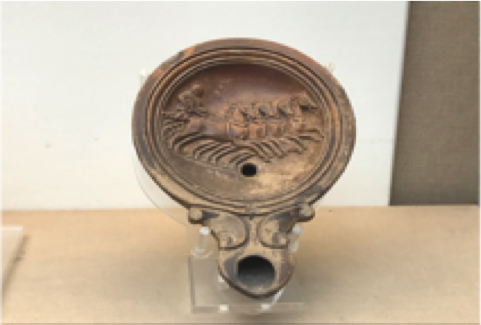 |
 |
|
An oil lamp showing an image of a
charioteer
|
A token from the Ashmolean museum
depicting a charioteer.
|
 |
|
A wax seal, from the British Museum,
depicting a horse and palm branch.
|
Chariot racing was perhaps the most popular sport in the Roman world, as can be seen when Lucian recounts that the “craze for horses is really great, you know, and men with a name for earnestness have caught it in great numbers” (Nigrinus, 29). In Rome, the event was held in the Circus Maximus, which could seat up to 150,000 people, and thus at any given time contain a sixth of the population. Horses feature commonly on tokens in many guises, such showing their domestic function of carrying heavy objects, but also, as seen above, in a more competitive atmosphere of the races. Since such imagery is seen elsewhere, such as an oil lamp, it clearly indicates tokens had a role within the stadia, possibly as entrance tickets for the races. Moreover, some tokens depict horses alongside palm branches. These branches are a symbol of victory, and the very same imagery can be seen on a wax seal from the 1-2nd century AD, also in relation to chariot racing. Thus it could also be suggested that tokens could commemorate a successful day at the races, or have a role in betting. Like today, the Romans would bet on horses, since chariot races involved four different teams, each with their own groups of supporters.
Furthermore, there is also a suggestion that tokens could have had a role in hunting. Hunting had been important in Roman society for centuries, starting as a way to catch food, but later developing into an elite hobby, intended to both train young men for military action, and improve their morality. Some aristocrats had game parks, and there are scenes of the hunt depicted in mosaics, to decorate the domestic space. This indicates how the sport was a popular pastime, and even a status symbol. Some images on tokens are very similar to this mosaic, showing a hunter closing in on a boar, holding his spear aloft. Perhaps therefore, tokens were invites to a hunt, or a commemorative item. This particular image however, could also have come from the games, as boars were hunted both privately, and as part of the entertainment provided in the amphitheatre.
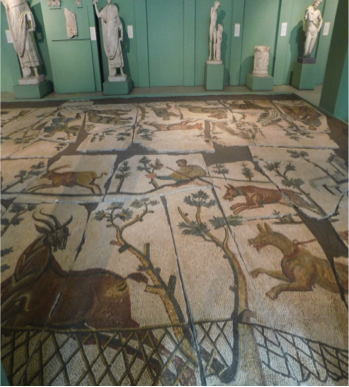 |
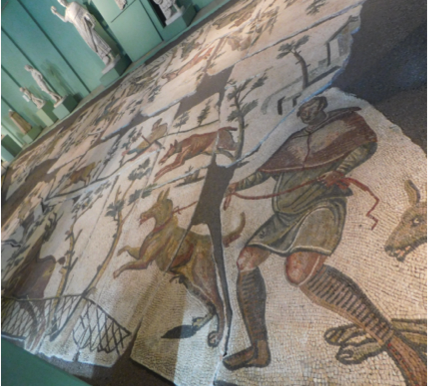 |
| Two scenes from a mosaic which depicts a wild hunt. |
Additionally, the games are perhaps one of the most famous aspects of the Roman world for the modern reader, and their importance can be seen in the way Juvenal suggests all the Roman people wanted was “bread and circuses” (Satires, 10). Alongside the famous gladiators, animal shows, called venationes, were commonly held. During these events, great effort was made to make the colosseum appear like a hunting ground, including the use of scenery, and many animals are recorded as being used, such as big cats, elephants, bears, and herbivores such as boar, deer, and more exotically, zebras. These unfortunate creatures were transported from the conquered provinces, as symbols of Roman superiority over nature, and their empire. Importantly, all these animals can be seen on tokens. Although many tokens are unclear because of the damage they have incurred over the centuries, lions and elephants are instantly recognisable because of their manes and tusks respectively. Elephants were important symbols during the games, and were even depicted coinage. Their size and strength made them signs of the emperor’s might and generosity, thus they became a representation of the games as a whole. Furthermore, lions were commonly used both in the games and images across the Roman world, such as mosaics, where they are seen as vicious, and fearful creatures, who would have been impressive in the amphitheatre. Both these animals therefore hint at the role tokens could have had in the games, again perhaps as a commemorative item.
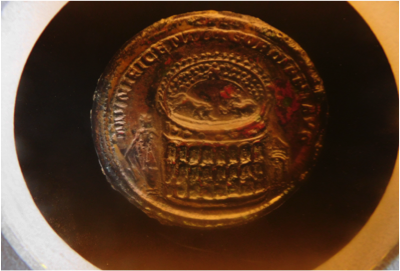 |
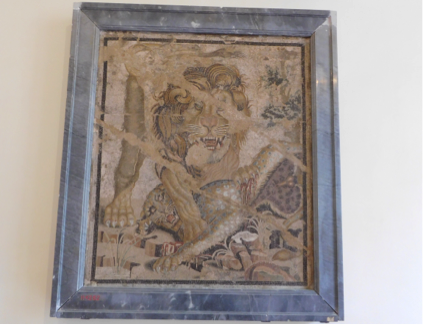 |
|
A Roman coin featuring an elephant fighting a big cat in the amphitheatre.
|
A mosaic from Pompeii depicting a lion. |
Perhaps the most illuminating piece of information about the use of tokens in relation to the games comes from literature. Martial tells us “now a large number of tessera allots animals which were watched…now a bird rejoices to fall into a safe lap and is assigned owners by lottery in its absence, to save it from being ripped apart” (Epigrams, 8.78.7-12). This seems to suggest that the meat of the animals would have been distributed to the crowds after the shows, using the tessera, the Latin word for tokens, for ease. Indeed there is no evidence of storage space, or the burial of the dead animals in the colosseum, and while this is disgusting to the modern reader, this practice would have provided a way to both please the populous, and deal with waste. This therefore seems like their most likely use, especially since some tokens do depict birds, as mentioned in the extract.
There are certainly many different examples of animal tokens, and many different possible uses for them, including both practical and commemorative functions. They show how tokens could be closely connected to the world of entertainment, as well as the variety of animals in Roman society.
 |
This month's piece was written by Rebecca Rolfe, a Classical Civilisation with Study in Europe student currently on her year abroad in Italy. She is interested in the importance of iconography in Roman artwork, and the symbolism of images on Roman coins. Over the summer of 2017 Becky conducted research on the animal tokens of Rome with the support of Warwick's Undergraduate Research Support Scheme. As part of her research she translated a segment of Rostovtzeff's Latin catalogue of Roman tokens related to spectacles into English. If you want to learn more about these tokens, the translation is available here!
Bibliography:
Anderson, John Kinloch (1985), Hunting in the Ancient World (Berkley, University of California Press).
Bell, Sinclair and Willekes, Carolyn (2014) ‘Horse Racing and Chariot Racing’, in The Oxford Handbook of Animals in Classical Thought and Life, ed Gordon Lindsay Campbell (Oxford, Oxford University Press) 478-491.
Harrison, George (2001), ‘Martial on Sportula and the Saturnalia’, in Mouseion: Journal of the Classical Association of Canada, Vol 1, No. 3, pages 295-312.
Jennison, George (1937), Animals for Show and Pleasure in Ancient Rome (Manchester, University of Manchester Press).
Kyle, Donald (2007), Sport and Spectacle in the Ancient World (Oxford, Blackwell).
MacKinnon, Michael (2014) ‘Hunting’, in The Oxford Handbook of Animals in Classical Thought and Life, ed Gordon Lindsay Campbell (Oxford,Oxford University Press) 203-216.
Meijer, Fik (2010), Chariot Racing in the Roman Empire (Baltimore, John Hopkins University Press).
Scullard, Howard Hayes (1974), The Elephant in the Greek and Roman World (London, Thames and Hudson).
Shelton, Jo-Ann (2014) ‘Spectacles of Animal Abuse’, in The Oxford Handbook of Animals in Classical Thought and Life, ed Gordon Lindsay Campbell (Oxford, Oxford University Press) 461-478.
Toynbee, Jocelyn (1973), Animals in Roman Life and Art (London, Thames and Hudson).
 Clare Rowan
Clare Rowan

 Please wait - comments are loading
Please wait - comments are loading

 Loading…
Loading…

